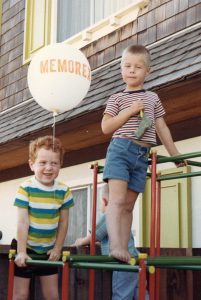The shapes of family
I still remember the tongue-lashing my teenage cousin and I received when we defended our widowed grandmother’s decision to file for divorce from her second husband. If the two of them couldn’t get along, we saw no reason why they should have to stay together. Mothers and aunts rounded on us. We didn’t know what we were talking about, they scolded. Grandma was a disgrace to the family. The Mother’s Union of our Anglican Church was going to throw her out, and her daughters were ashamed to show their faces in town.
Tauranga, New Zealand, was a tightly traditional little town in the 1940s and 50s, when I was growing up. Fathers worked, mothers stayed home with children. I didn’t know any single parent families. If there were divorcees, they were invisible. So were lesbians and gays.
My social environment in England was almost as sheltered. My friends were other young marrieds with small children. Our close of new row houses was filled with intact families like ours.
When we moved to Cupertino, CA in 1967, we lived in a complex of townhouse apartments. Each apartment had a 20 ft. by 10 ft. fenced yard. Our yard was filled with a climbing tower, a sand box, sundry tricycles, pushcarts, and other paraphernalia to keep our two small boys entertained. The neighbors helped open my eyes to other family structures: single parents, grandparents raising kids, abusive relationships.
The memory of my grandmother’s divorce comes back to me as I read a letter to my parents. After thanking them for our two-year-old’s birthday gift, I wrote:
17 Nov. 1967
Simon had a lovely little birthday party – a lunch for three little friends – after school the apartment is invaded with older kids, which would have caused problems. We seem to run a regular play centre here, what with the climbing tower and sandbox, and the new easel, with apparently unlimited supply of crayons & paper. However, the opportunities for recreation are so limited in these apartments, and so many of these kids from broken or otherwise mixed-up homes, that I guess its our contribution to the community.
There’s a self-righteousness tone to this comment, an indication of my awakening to the variety of household shapes in this new environment. A hint of defiance too. I wonder, was I getting back at my mother and aunts for their dismissal of my grandmother’s decision so many years ago?


The 50’s seems another century ago. I knew very little about homosexuality (heard in-jokes) nothing about transgender or “Drag” or Crossdressing. I was very naive even though married in 1951. Now it is all so public I get confused. I remember my father saying “there are 3 sexes” Women had difficulty in society obtaining a divorce and only the strong determined women succeeded.
Yes I too, Maureen was raised in the 50’s so would have the same
“proper” upbringing as you, but raised in a large city, with more sophistication,(which sadly) I have relaxed with in performance,am
less formal these days, but still conservative in thinking.
My Grandmother divorced her husband in the 40’s and no one really criticized her. I did not know of this divorce until I was in my late teens, when adults brought this subject up.
Actually, Linda, the two other little boys in the picture with David are neighbors, named Geoffrey (in front) and Mike (with back to the camera). Simon at that time was barely two, and not into playing with the big boys.
“Tongue lashing” is a phrase I’d forgotten, yet it so aptly describes what we can do to each other with words. Words can also heal, as you have shown with your poems.
Aw, what a great pic of Simon and David!
Love the story about your grandma. It’s true that back in that time divorce was never spoken about, yet it touched many families.